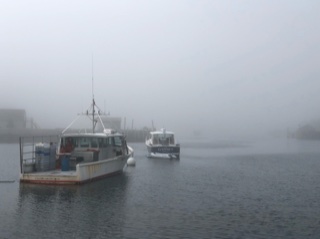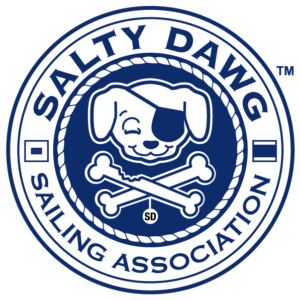|
LOBSTER AND PEA SOUP Coping with Fog and Lobster Pots Written by Jeremy Bloxham
Fog is intimidating in part because there’s always that feeling that if I can see 25 yards ahead that means there’s a brick wall of fog 25 yards ahead. Of course, 25 yards ahead, one can see another 25 yards ahead, and so on. With modern GPS and a chart-plotter there’s really no excuse for bumping into rock in fog. But then there are other boats. Most have AIS and are readily avoided, but almost none of the many lobster boats have AIS, and they charge around frequently changing direction as they recover and lay their traps. Fortunately, they are very noisy (they don’t have mufflers on their dry stack exhausts) so you will hear them from far off, and can often associate a target on radar with the noise. They are also very good at avoiding other boats. Position someone on deck with a clear view ahead to spot navigation marks and hazards, and have someone else in charge of navigation, since it’s easy to lose your sense of direction. Do have a fog horn with spare canisters and don’t hesitate to sound it frequently. There are several million lobster traps in Maine. Sometimes it seems like that is an understatement. In fact, there are so many that trap bait is now a significant part of the diet of young lobsters. Fishing or farming?
Lobstering gear, for the most part, comes in two forms, and it is important to understand what you are dealing with. The first kind is a simple rising line from the line of traps on the sea floor to a pickup buoy on the surface. The second kind adds a so-called toggle that supports the rising line with an attached pickup buoy some 20 to 50 feet away. The line connecting the pickup buoy and the toggle lurks a few feet beneath the surface and runs parallel to the current. In strong current, the toggles are sometimes submerged. Just to make things more interesting, the toggles are often a different color from their attached pickup buoy (although we find that each lobsterman is consistent in the colors he uses for his pick-up buoys and his toggles; e.g. the blue toggles always go with the green and white pick-up buoys). In deep water, a single pickup buoy will likely be standing upright, while a pickup buoy attached to a toggle will likely be lying on its side (it’s not taking the load from the rising line) and will be pointing back towards its toggle. From East Penobscot Bay eastward, toggles predominate; further west, you’re more likely to see the simpler gear. Offshore, in deep water the configuration of the gear is somewhat different, but the buoys then are typically much larger and have a flag, and so are easier to spot. Some even have radar reflectors. In areas of dense lobstering (such as Jericho Bay pictured here) If you do catch a lobster line then please do all you can not to cut it, and if you do then try to re-attach the line so that someone who’s only trying to make a living doesn’t lose their gear. I’m personally against the use of prop cutters for that reason, though others may feel differently. The lobstermen and lobsterwomen are our fellow seafarers and will often come to the aid of pleasure boats. I must admit when they blast out of harbor at 5am or earlier I sometimes feel a little less sympathetic to their plight. We’ve never caught a line around our prop. I think folding props are less vulnerable (the blades seem to get knocked inward by the line) and besides our 8‘6” T-keel catches them first. With a line on the keel we simply back down, but if we’re going fast enough it will sometimes just come off by its own accord as the traps on the sea floor drag the pickup buoy around our keel. Is cruising in Maine worth all this fuss? Absolutely! |

 Fog and lobster pots can make cruising in Maine a little intimidating. We were certainly intimidated by fog when we first cruised Maine in 1988 on our 30’ sailboat with no radar, GPS or chart-plotter (or pressurized freshwater for that matter) -- we had to plot our position using the Loran C lines that were overprinted on charts. Well, since then navigation has become much more straightforward, though there are even more lobster pots today.
Fog and lobster pots can make cruising in Maine a little intimidating. We were certainly intimidated by fog when we first cruised Maine in 1988 on our 30’ sailboat with no radar, GPS or chart-plotter (or pressurized freshwater for that matter) -- we had to plot our position using the Loran C lines that were overprinted on charts. Well, since then navigation has become much more straightforward, though there are even more lobster pots today.
 we find a good strategy is to identify lanes through the buoys: Katie will stand on deck (getting some elevation above sea level helps) feeding me information like “turn to port 15 degrees in 2 boat lengths” to get in the next lane. With fog in the mix, too, she will take the autopilot remote while I look at the radar.
we find a good strategy is to identify lanes through the buoys: Katie will stand on deck (getting some elevation above sea level helps) feeding me information like “turn to port 15 degrees in 2 boat lengths” to get in the next lane. With fog in the mix, too, she will take the autopilot remote while I look at the radar.
